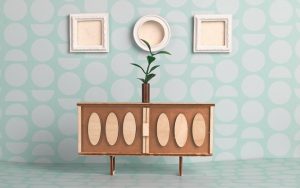In the ever-evolving world of interior design, certain furniture pieces have left an indelible mark on the landscape, transcending time and trends. Among the most influential and cherished styles is Mid-Century Modern, an era characterized by its clean lines, organic forms, and innovative materials.
Within this design movement, 5 iconic furniture pieces emerged, each defining an era and captivating the hearts of generations to come. In this blog post, we embark on a journey to explore the allure of these timeless creations that have stood the test of time, remaining as relevant and captivating today as they were decades ago.
Eames Lounge Chair and Ottoman: The Epitome of Comfort and Style
The world of furniture design has seen its fair share of iconic creations, but none quite like the Eames Lounge Chair and Ottoman. Revered for its timeless elegance and unparalleled comfort, this mid-century modern masterpiece has solidified its place in history as a symbol of sophistication and style. Let’s delve into the fascinating story of this iconic duo and explore the reasons behind its enduring popularity.
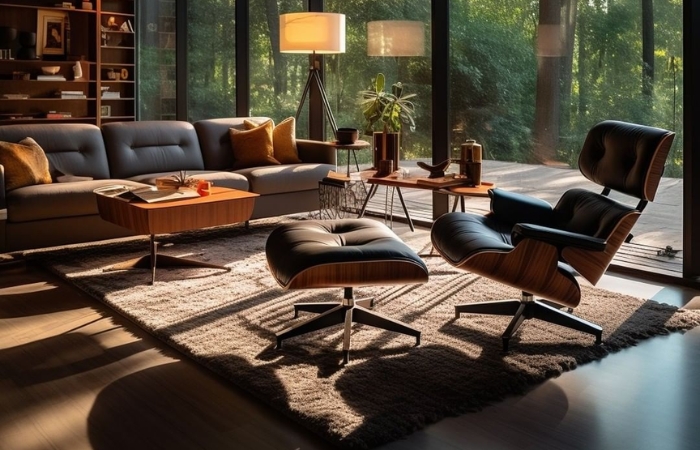
The Visionaries Behind the Design: Charles and Ray Eames
At the heart of the Eames Lounge Chair and Ottoman lies the genius of Charles and Ray Eames, the husband-and-wife duo who revolutionized design in the mid-20th century. Renowned for their multidisciplinary approach, the Eameses were architects, designers, and filmmakers who believed in creating functional yet visually striking pieces that would stand the test of time. Their deep understanding of materials and innovative production techniques set them apart as true pioneers in the world of furniture design.
Unveiling the Icon: A Look at the Eames Lounge Chair
The Eames Lounge Chair, first introduced in 1956, immediately captured the imagination of design enthusiasts with its distinctive silhouette and inviting presence. Its ergonomic design and meticulously crafted curves offer the perfect blend of comfort and style. Featuring sumptuous leather upholstery and a warm walnut shell, the chair exudes an air of luxury and refinement.
The Art of Craftsmanship: Materials and Techniques Used
Craftsmanship lies at the core of the Eames Lounge Chair’s enduring appeal. The materials used in its construction were carefully chosen to ensure both durability and aesthetics. From the rich, hand-selected wood veneers to the supple leather cushions, every element is a testament to the Eameses’ commitment to quality and detail. The chair’s construction involved intricate assembly techniques, showcasing the artisans’ dedication to perfection.
Its Impact on Pop Culture and Design Trends
The Eames Lounge Chair and Ottoman quickly became a symbol of mid-century modern design and a staple in high-end interiors. Its appearance in television shows, films, and iconic photographs alongside famous figures elevated its status, making it an aspirational piece for design connoisseurs and enthusiasts alike. Even today, its presence in contemporary media and popular culture continues to reinforce its status as an everlasting design icon.
Enduring Legacy: Still Relevant and Beloved Today
Decades after its debut, the Eames Lounge Chair and Ottoman remain as captivating as ever. Its classic yet contemporary design effortlessly complements a wide range of interior styles, from modernist and minimalist to eclectic and transitional. As a testament to its lasting appeal, numerous manufacturers continue to produce high-quality replicas and adaptations that allow a broader audience to experience the allure of this iconic duo.
Noguchi Coffee Table: Sculptural Elegance for Every Space
Among the many iconic mid-century modern furniture pieces, the Noguchi Coffee Table stands out as a true work of art that seamlessly blends sculptural elegance with functional design. Created by the visionary artist and designer Isamu Noguchi, this iconic table has transcended time and continues to grace living rooms, offices, and galleries around the world. Let’s explore the captivating story behind the Noguchi Coffee Table and discover why it remains a timeless symbol of sophistication and style.
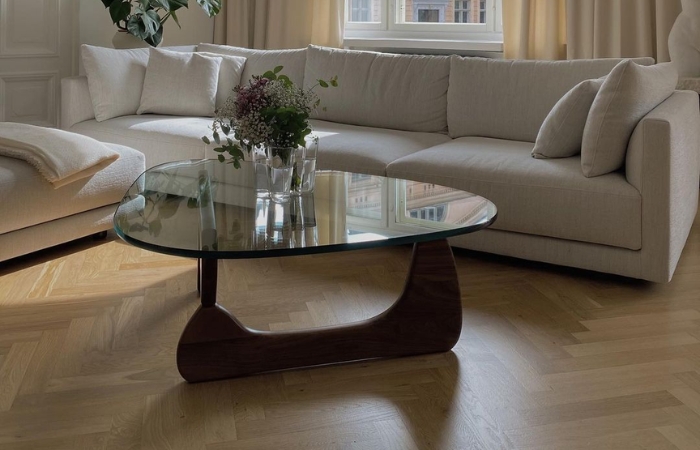
The Genius of Isamu Noguchi: A Renowned Artist and Designer
Isamu Noguchi was a multifaceted creative force known for his sculptural works, gardens, and furniture designs. His background in art and architecture allowed him to approach design with a unique perspective, seamlessly blending elements of both disciplines. Inspired by his Japanese heritage and the principles of modernism, Noguchi’s designs often explored the harmony between organic forms and geometric shapes.
The Distinctive Features of the Noguchi Coffee Table
The Noguchi Coffee Table, introduced in 1947, is characterized by its visually striking composition. The table features a free-form glass top, gracefully supported by two identical interlocking wooden base pieces. This clever design creates a sense of balance and harmony, giving the table its signature sculptural quality. The smooth, flowing lines of the table’s base evoke a sense of movement and fluidity, making it an eye-catching centerpiece in any space.
Versatile Aesthetics: Complementing Diverse Interior Styles
One of the remarkable qualities of the Noguchi Coffee Table is its ability to complement various interior styles effortlessly. Whether placed in a contemporary, mid-century, or eclectic setting, the table seamlessly integrates itself into the overall decor, adding an element of sophistication and artistic allure. Its timeless design ensures that it transcends fleeting trends, allowing it to remain relevant in ever-evolving design landscapes.
The Functional Sculpture: Blending Form and Function
Beyond its artistic appeal, the Noguchi Coffee Table is a prime example of form meeting function. The glass top provides a practical surface for placing coffee cups, books, and other decorative items, while the sculptural base adds visual interest without sacrificing stability. Its low profile makes it ideal for creating an open and inviting atmosphere in living spaces, encouraging a sense of connectivity and conversation.
Iconic Installations: Noguchi’s Impact on Art and Design
Isamu Noguchi’s artistic vision extended beyond furniture design. His sculptures and public installations have left an indelible mark on the world of art and landscape architecture. Notably, Noguchi’s Akari light sculptures and garden designs further exemplify his ability to merge art with the environment. The Noguchi Coffee Table, as an integral part of his body of work, represents his ethos of harmonizing aesthetics with utility.
Barcelona Chair: Timeless Luxury and Modernist Mastery
The Barcelona Chair, a pinnacle of modernist design, exudes an aura of timeless luxury and sophistication that has captivated design enthusiasts for decades. Designed by the visionary architect Ludwig Mies van der Rohe, this iconic chair embodies the essence of modernism with its sleek lines, impeccable craftsmanship, and unparalleled comfort. Let’s delve into the fascinating history of the Barcelona Chair and explore the reasons behind its enduring allure.
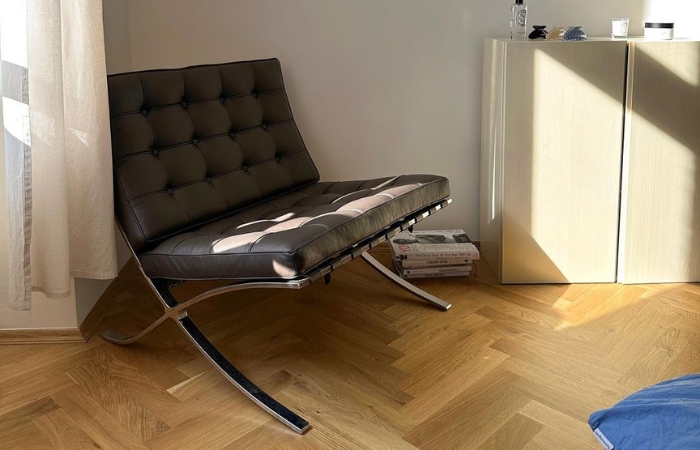
The Creative Mind: Mies van der Rohe and the Barcelona Chair
Ludwig Mies van der Rohe, an architectural mastermind of the 20th century, played a pivotal role in shaping modernist architecture and design. As the director of the German Bauhaus school and later a prominent figure in the International Style movement, Mies was known for his “less is more” philosophy. The Barcelona Chair, designed in 1929 for the German Pavilion at the International Exposition in Barcelona, reflects Mies’s commitment to purity of form and function.
Unraveling the Barcelona Chair’s Striking Design Elements
The Barcelona Chair’s design is a study in elegant simplicity. Its clean, geometric lines create a visual harmony that epitomizes modernist aesthetics. The chair features a stainless steel frame, meticulously hand-polished to a lustrous finish, with straps of supple leather cradling the seat and backrest. The “X” shape of the frame and the graceful curve of the armrests are not only visually appealing but also contribute to the chair’s exceptional comfort.
The Significance of Materials: Leather, Stainless Steel, and Innovation
The choice of materials used in the Barcelona Chair played a crucial role in its enduring appeal. The use of high-quality leather upholstery adds a touch of luxury and richness to the design, while the stainless steel frame represents a departure from traditional chair construction at the time. Mies’s innovative use of these materials set new standards for furniture design and pushed the boundaries of what was possible in the realm of interior furnishings.
A Seat Fit for Royalty: The Chair’s Influence on High-End Design
The Barcelona Chair was an immediate sensation, praised for its regal elegance and exceptional craftsmanship. Its debut at the Barcelona Pavilion showcased its inherent luxury and set the stage for its continued popularity among elite circles. Over the years, the chair has become synonymous with refined taste and opulence, making it a coveted piece in upscale interiors, executive offices, and exclusive lounges worldwide.
Modern Reinterpretations: Adapting the Barcelona Chair for Today
While the original Barcelona Chair remains an iconic symbol of modernist design, contemporary designers and manufacturers have embraced its timeless appeal by creating various reinterpretations and adaptations. These adaptations cater to a broader audience, offering diverse color options, additional cushioning, and environmentally sustainable materials. The Barcelona Chair’s adaptability to evolving tastes while retaining its essence underscores its status as a true design masterpiece.
Saarinen Tulip Table: An Organic Marvel of Mid-Century Design
In the realm of mid-century modern furniture, the Saarinen Tulip Table stands as a captivating example of organic elegance and innovative design. Conceived by the brilliant Finnish-American architect and designer Eero Saarinen, this iconic table broke away from traditional four-legged designs, presenting a seamless and sculptural form that defied convention. Let’s delve into the fascinating story behind the Saarinen Tulip Table and discover why it remains a timeless symbol of mid-century modernism.
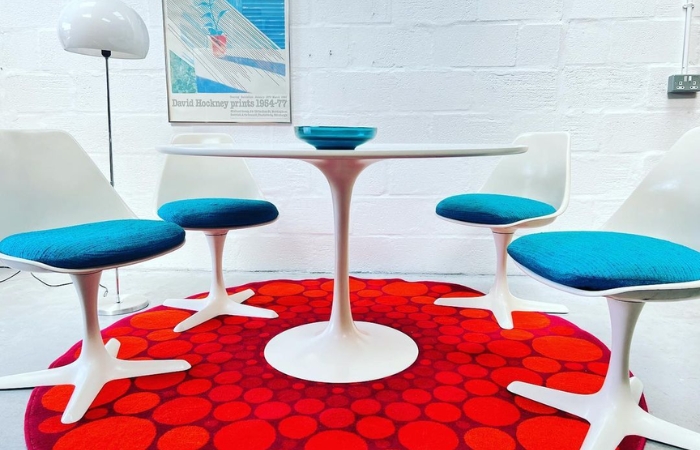
Eero Saarinen’s Architectural Genius and Design Vision
Eero Saarinen’s reputation as an architectural visionary extended far beyond his time. As the son of renowned architect Eliel Saarinen, he was destined to make an indelible mark on the design world. With a keen eye for balance and harmony, Saarinen sought to create pieces that blended organic shapes with functional efficiency. The Saarinen Tulip Table emerged as one of his most celebrated masterpieces, embodying the essence of his creative genius.
The Unique Concept Behind the Saarinen Tulip Table
The Saarinen Tulip Table, introduced in 1956, is characterized by its single pedestal base, which deviated from the conventional four-legged table design of its era. This innovation not only provided visual intrigue but also offered practical advantages, such as eliminating the clutter of table legs and providing more seating space around the table. The table’s smooth, rounded form resembles the elegant silhouette of a tulip in bloom, hence its name.
Functional Elegance: Exploring Its Practical Benefits
Beyond its aesthetic appeal, the Saarinen Tulip Table boasts exceptional functionality. Its pedestal base allows for flexible placement of chairs, accommodating various seating arrangements and promoting seamless conversation during gatherings. The absence of corners and legs also makes cleaning and maintenance effortless, adding to its appeal as a practical and user-friendly piece of furniture.
Pairing Perfection: Chairs and Settings for the Tulip Table
The versatility of the Saarinen Tulip Table extends to its compatibility with various chair designs. Its understated elegance harmonizes beautifully with both classic and contemporary chairs, such as the Saarinen Tulip Chairs or iconic mid-century modern pieces. Whether used in dining areas, meeting rooms, or as a statement piece in a foyer, the table effortlessly complements its surroundings and enhances the overall aesthetic.
Contemporary Revivals: Saarinen’s Timeless Influence
Eero Saarinen’s innovative design language continues to resonate with contemporary audiences, leading to the reimagining of the Saarinen Tulip Table in various materials, finishes, and sizes. Today, enthusiasts can choose from an array of options, including marble, wood, or durable laminates, allowing the table to adapt to diverse interior styles and preferences. This adaptability ensures that the Saarinen Tulip Table remains a cherished piece in modern homes and commercial spaces alike.
Eames Molded Plastic Chair: The Icon of Affordable Innovation
In the realm of mid-century modern design, the Eames Molded Plastic Chair holds a unique place as an iconic symbol of affordability and innovation. Designed by the legendary husband-and-wife team Charles and Ray Eames, this revolutionary chair introduced a new era of mass-produced, affordable furniture without compromising on style or comfort. Let’s delve into the fascinating story behind the Eames Molded Plastic Chair and discover how it became a timeless icon of modern design.
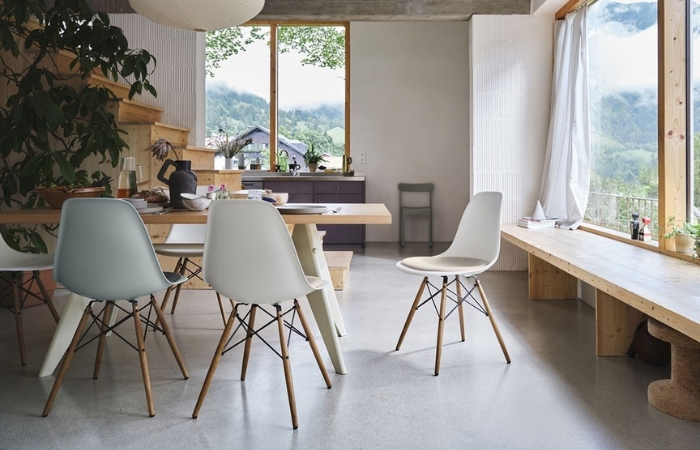
The Dynamic Duo Strikes Again: Eames and Their Plastic Chair
Charles and Ray Eames were no strangers to groundbreaking design. Renowned for their contributions to architecture, furniture, and film, the Eameses were celebrated for their ability to blend art and function seamlessly. In the early 1950s, they embarked on a mission to create a chair that was not only visually appealing but also accessible to a broader audience. The result was the Eames Molded Plastic Chair, a true marvel of affordable innovation.
The Evolution of the Molded Plastic Chair: From Experiment to Icon
The journey of the Eames Molded Plastic Chair began with a bold experiment in materials. The Eameses sought to create a single-shell chair using molded fiberglass, an innovative and cost-effective material at the time. The breakthrough design was initially introduced as a fiberglass-reinforced plastic chair in 1950. Over the years, advancements in manufacturing techniques led to the adoption of polypropylene, making the chair even more affordable and eco-friendly.
Accessibility and Versatility: Reasons Behind Its Popularity
One of the key factors that propelled the Eames Molded Plastic Chair to widespread popularity was its accessibility. Unlike many high-end designer chairs of its time, this iconic piece was priced within reach of the average consumer, democratizing modern design and making it accessible to homes, offices, and public spaces worldwide. The chair’s versatile design also meant that it could be utilized in a myriad of settings, from dining rooms to boardrooms and beyond.
A Revolution in Furniture: Changing the Game of Mass Production
The Eames Molded Plastic Chair marked a turning point in the world of furniture design, revolutionizing the concept of mass production. The innovative use of molded plastic allowed for streamlined manufacturing, reducing production costs and making the chair more affordable to a broader audience. This groundbreaking approach to production set new standards for the furniture industry and left a lasting impact on design practices.
Design for the People: The Eames’ Legacy of Democratic Design
Above all, the Eames Molded Plastic Chair embodies the Eameses’ philosophy of democratic design—design that is accessible, functional, and aesthetically pleasing to people from all walks of life. Their commitment to creating furniture that improves lives and enhances everyday experiences resonates in the enduring appeal of this iconic chair. As a symbol of affordable innovation, the Eames Molded Plastic Chair continues to inspire generations, proving that great design can be both attainable and transformative.
Conclusion
From the revolutionary vision of Charles and Ray Eames to the sculptural elegance of Isamu Noguchi and the timeless luxury of the Barcelona Chair, each creation carries with it a tale of innovation, craftsmanship, and enduring appeal. These furniture pieces not only provided functional solutions but also embodied the spirit of an era, a movement that sought to blend art, design, and technology seamlessly.


